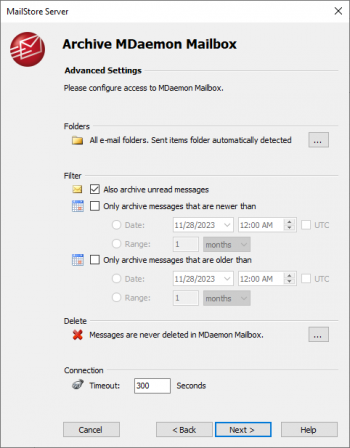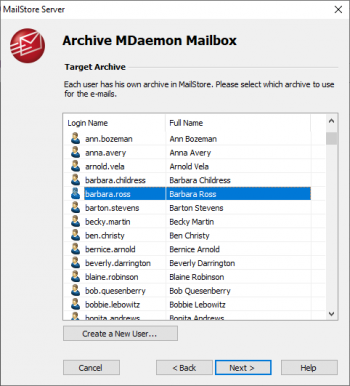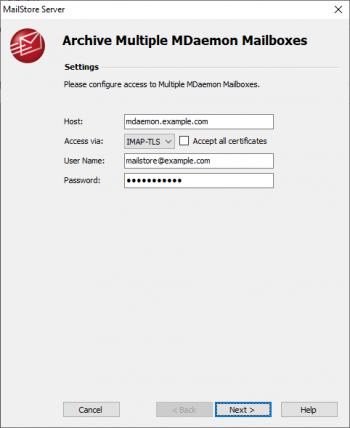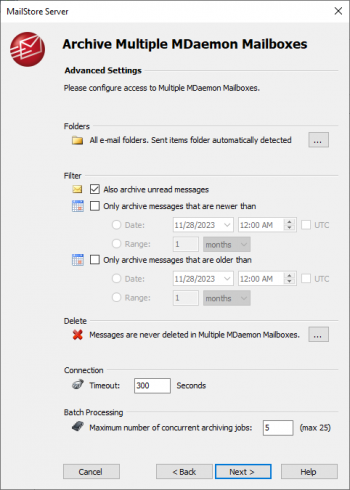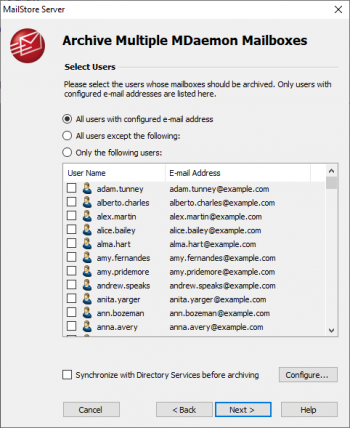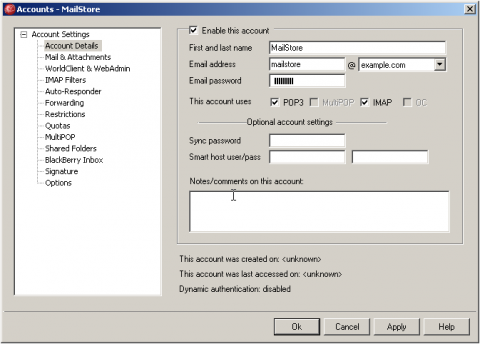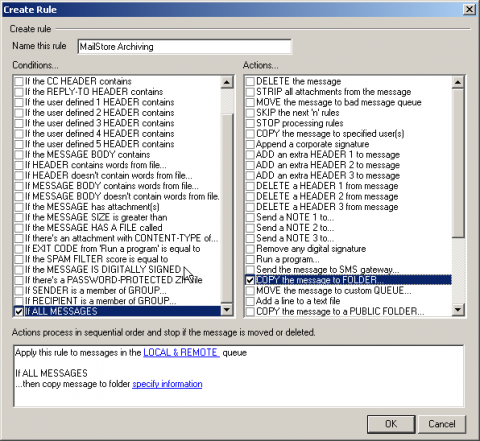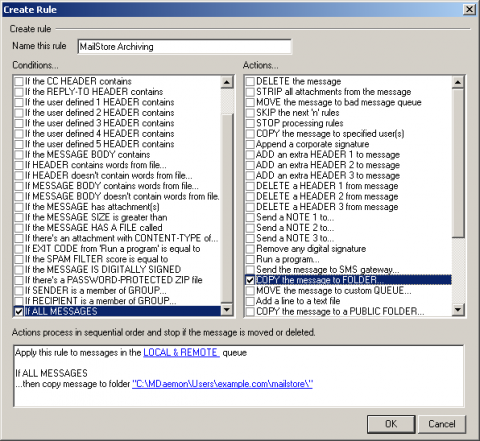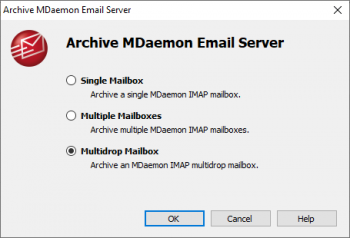Difference between revisions of "Archiving Emails from MDaemon"
| [unchecked revision] | [unchecked revision] |
| Line 70: | Line 70: | ||
=== Step 3: Configuration of MailStore Server === | === Step 3: Configuration of MailStore Server === | ||
| − | {{Archiving Multidrop Mailbox|Alt-N MDaemon}} | + | {{Archiving Multidrop Mailbox|Alt-N MDaemon|Mdaemon_catchall_00.png|Mdaemon_catchall_01.png|Mdaemon_catchall_02.png}} |
== Weblinks == | == Weblinks == | ||
Revision as of 14:12, 30 June 2014
This implementation guide covers the specifics of archiving MDaemon Server mailboxes. It is assumed that you already have a MailStore Server installation or test installation and are familiar with the fundamentals of MailStore Server. Please refer to the Manual or the Quick Start Guide for more information.
MailStore Server offers several ways to archive emails from MDaemon Server mailboxes, which are described below. If you are not sure which archiving method best suits your company, please refer to the chapter Choosing the Right Archiving Strategy.
}
Synchronizing Users
In addition to the internal user databases, MDaemon may also use SQL databases or LDAP directory services such as Active Directory or OpenLDAP to manage and authenticate users. It is recommended to set up directory service synchronization in MailStore as well. Additional information on synchronizing users can be found in the corresponding chapters of the MailStore Server manual:
Archiving Individual Mailboxes
In MailStore Server MDaemon archiving tasks are stored in archiving profiles. By following the procedure described here you can archive a single MDaemon mailbox for a specific MailStore user. The archiving process can be executed manually or automatically. You can find further information about executing archiving profiles in chapter Email Archiving with MailStore Basics.
- Users can only archive their own mailboxes to their personal user archive. To archive the emails of other users, you have to be logged on to MailStore Client as MailStore administrator. Only MailStore administrators can archive the emails of other users.
- In MailStore, click on Archive Email.
- To create a new archiving profile, select Alt-N MDaemon from the Email Servers list in the Create Profile area of the application window.
- A wizard opens guiding you through the setup process.
- Select Single Mailbox and click on OK.
- Fill out the fields Email Address, Host, Access via, User Name and Password. The Email Address is used to label the folder that is created in the archive by this profile. Click on Test to verify the data entered.
- For the IMAP-TLS and IMAP-SSL protocols only: If the certificate provided by the remote host cannot be verified (e.g. self-signed or signed by an unknown certificate authority), enable the option Accept all certificates to allow MailStore to establish a connection. As this option leads to an insecure configuration, warnings may appear in the summary and/or the dashboard.
- Click on Next.
- Customize the list of folders to be archived (IMAP only), the filter (IMAP only) and the deletion rules. By default, no emails will be deleted from a mailbox. The timeout value only has to be adjusted as needed (e.g. with very slow servers).
- Click on Next.
- If logged on to MailStore Server as administrator, the target archive can be specified at the next step. Select the archive of the user for whom the mailbox is to be archived.
- At the last step, a name for the new archiving profile can be specified. After clicking on Finish, the archiving profile will be listed under Saved Profiles and can be run immediately, if desired.
Archiving Multiple Mailboxes in One Step
- Log on to MailStore Client as administrator.
- Click on Archive Email.
- From the Email Servers list under Create Profile select Alt-N MDaemon to create a new archiving profile.
- A wizard opens to assist in specifying the archiving settings.
- Select Multiple Mailboxes.
- In order to be able to archive multiple mailboxes, some MailStore users along with their email addresses have to exist in the MailStore user management.
- Under Host enter the name or IP address of your MDaemon server.
- From Access via select the protocol used to access the MDaemon server. It is recommended to select either IMAP-TLS or IMAP-SSL.
- Please Note: When using the IMAP-TLS or IMAP-SSL protocols with a self-signed SSL certificate, you have to set the option Ignore SSL security warnings if you want to execute the archiving profile based on a scheduled task. Otherwise the execution of the task will fail.
- Under User Name and Password, enter the access data of a user who has access to all the MDaemon mailboxes to be archived. This is usually a MDaemon administrator.
- Under Special Folder (optional) you may enter the name of the IMAP folder containing sent messages.
- Click on Next to continue.
- If needed, adjust the settings for the list of folders to be archived, the filter and the deletion rules. By default, no emails will be deleted from the mailbox. The Timeout value only has to be adjusted in specific cases (e.g. with very slow servers). Please keep in mind that these settings apply to all mailboxes to be archived.
- Click Next to continue.
- Select the users whose mailboxes are to be archived. The following options are available:
- All users with configured email address
- Choose this option to archive the mailboxes of all users who are set up in MailStore's user management along with their email addresses.
- All users except the following
- Choose this option to exclude individual users (and thereby their MDaemon mailboxes) from the archiving process using the list of users below.
- Only the following users
- Choose this option to include individual users (and thereby their MDaemon mailboxes) in the archiving process using the list of users below. Only the mailboxes of those users explicitly specified will be archived.
- Synchronize with Active Directory before archiving
- If selected, the MailStore user list will be synchronized with a directory service before any archiving process is executed. This has the advantage that, for example, new employees will be created as MailStore users before archiving, so once the archiving process is executed, their MDaemon mailbox is archived automatically as well. This option is especially recommended when the archiving process is to be executed regularly according to a schedule.
- Finally, a name for the archiving profile can be specified. After clicking on Finish, the archiving profile will be listed under Saved Profiles and can be executed right away.
More information on how to execute archiving profiles can be found in chapter Email Archiving with MailStore Basics.
Archiving Incoming and Outgoing Emails Directly
The MDaemon mail server offers an easy way to deliver all emails to an MDaemon specific multidrop mailbox. MailStore Server archives this mailbox by means of an archiving task of type Archiving IMAP and POP3 Multidrop Mailboxes.
Step 1: Create a new account to be used as multidrop mailbox for archiving
- Add a new account by selecting Accounts and then New Account.
- Name the account mailstore and assign a strong password.
- In the following screenshot you can see the sample configuration for the mailbox [email protected]
Step 2: Create a new content filter rule for archiving
- Open the content filter editor by selecting Security an then Content Filter.
- If not yet enabled, enable the rules processing engine.
- Click on New rule.
- Choose a name for the new rule, e.g. "MailStore Archiving".
- Under Conditions... select the checkbox If ALL MESSAGES and under Actions... select the checkbox COPY the message to FOLDER....
- In the text area on the bottom of the window, click on the link specify information.
- In the window Copy message to folder... click on Browse.
- Select the directory of the account you created in step 1.
- Click on OK to confirm the path specified.
- The configuration is now complete.
- Click on OK to save the new content filter rule.
Step 3: Configuration of MailStore Server
Setting up archiving processes for multidrop mailboxes is done using archiving profiles. General information about archiving profiles is available in chapter Working with Archiving Profiles.
Please proceed as follows:
- Log on as MailStore administrator using MailStore Client.
- In MailStore, click on Archive Email.
- To create a new archiving profile, select Alt-N MDaemon from the Email Server list in the Create Profile area of the application window.
- A wizard opens guiding you through the setup process.
- Select Multidrop Mailbox and click OK.
- Please note: To be able to archive a multidrop mailbox, MailStore Server users along with their email addresses must exist in the MailStore Server user management. If this is not the case, MailStore Server will offer to set up and run the Mdaemon_catchall_02.png at this point. Once completed, the wizard will resume.
Alternatively, you can cancel the wizard and create users manually as described the in chapter User Management.
- Please note: To be able to archive a multidrop mailbox, MailStore Server users along with their email addresses must exist in the MailStore Server user management. If this is not the case, MailStore Server will offer to set up and run the Mdaemon_catchall_02.png at this point. Once completed, the wizard will resume.
- Fill out the fields Access via, Host, Username and Password. Click on Test to verify the data entered.
- For the TLS and SSL protocols only: If the certificate provided by the remote host cannot be verified (e.g. self-signed or signed by an unknown certificate authority), enable the option Accept all certificates to allow MailStore to establish a connection. As this option leads to an insecure configuration, warnings may appear in the summary and/or the dashboard.
- Adjust any further settings such as how to handle emails with unknown addresses or asking MailStore to delete emails after they have been archived. The latter option is especially sensible when dealing with mailboxes that are exclusively used for archiving.
- The placeholders {u-email} or {h-email} can be used under Target Folders. {u-email} represents a user's primary email address and {h-email} is the email address found in the email header. Should a user have multiple aliases, using {h-email} will result in emails sent to different aliases of a user being archived in different folders, while using {u-email} will file all emails below the primary email address.
- Notice: If you are additionally archiving messages from the users mailboxes, you have to set the target folder names here to the folder names that match the names that were created by the user mailbox archiving profiles. Otherwise, additional or similar folders could be created in the users' archives. The folder names are case-sensitive.
- If the option Synchronize with Directory Services before archiving is enabled, the MailStore user list will be synchronized with configured directory service before the archiving process actually runs. This has the advantage that, for example, new employees will be created as MailStore users before archiving which enables MailStore to sort their emails into the correct archives.
- Click on Next.
- The timeout value only has to be adjusted on a case-by-case basis (e.g. with very slow servers).
- Click on Next.
- At the last step, select a name for the new archiving profile. After clicking on Finish, the archiving profile will be listed under Saved Profiles and can be run immediately or automatically, if desired.


